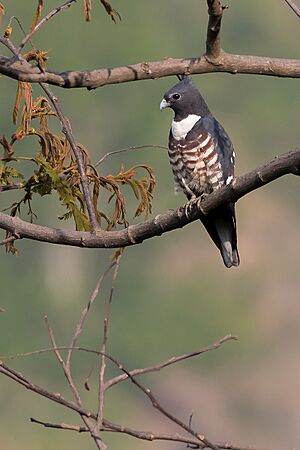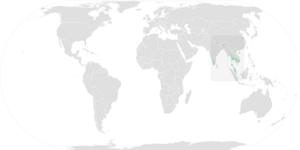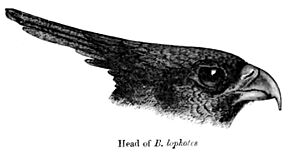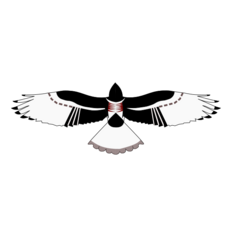Black baza facts for kids
Quick facts for kids Black baza |
|
|---|---|
 |
|
| Conservation status | |
| Scientific classification | |
| Genus: |
Aviceda
|
| Species: |
leuphotes
|
 |
|
| Global range Year-Round Range Summer Range Winter Range | |
| Synonyms | |
|
Falco leuphotes |
|
The black baza (Aviceda leuphotes) is a small bird of prey that lives in forests. You can find them in places like Northeast India, the eastern Himalayas, China, and Southeast Asia. Many black bazas travel long distances, like those from India. They fly south to the Peninsula and Sri Lanka for winter. These birds have short, strong legs and feet with powerful claws. They also have a noticeable crest on their heads. Black bazas often live in thick forests, sometimes in small groups. You might spot them sitting on tall tree branches that stick out above the forest.
Contents
Understanding the Black Baza's Family Tree
Scientists group living things into families. This helps us understand how they are related. The black baza was first described a long time ago. It was found in Pondicherry and called Falco leuphotes.
There are a few different types, or "races," of black bazas. These types are found in different places. For example, A. l. syama lives from eastern Nepal to southern China. It flies to other parts of Asia for winter. Another type, A. l. andamanica, lives only on the Andaman Islands. This one has white feathers on its belly without any brown stripes. Scientists are still studying these different types to learn more about them.
What Does a Black Baza Look Like?
The black baza is a small bird of prey with unique colors. It is about 30 to 35 centimeters (12 to 14 inches) long. Its wingspan (how wide its wings are when spread) is about 66 to 80 centimeters (26 to 31 inches). It weighs between 168 and 224 grams (about 6 to 8 ounces). When a black baza is sitting, its upright crest and bold patterns make it easy to spot.
Male black bazas have white feathers on their shoulders and wings. Female black bazas have white only on their shoulders. They also have more brown stripes on their underside compared to males.
When flying, black bazas can look a bit like crows. They often fly in small groups, especially when they are migrating. During migration, many of them gather together to rest. They are more active around sunset or on cloudy days.
How Do Black Bazas Find Food?
Black bazas mostly eat insects. They catch insects by flying out from a perch, which is called hawking. They grab the insects with their feet. Sometimes, they also pick insects off leaves. They have even been seen trying to catch small birds like wagtails. Black bazas sometimes join mixed-species foraging flocks. These are groups of different bird species hunting for food together. They have also been known to eat the fruits of oil palm trees.
The black baza makes a call that sounds like "chu-weep." It can also make a soft squeal or a shrill, gull-like sound. Like other birds in their family, Aviceda, they have two small, tooth-like bumps on the edge of their upper beak.
Where Do Black Bazas Live?
This bird species lives in Southeast Asia and parts of South Asia. Some black bazas travel between different areas depending on the season. For example, many migratory birds are seen in places like Chumphon in Thailand. They make up a large part of the birds of prey passing through. In Hong Kong, some black bazas have started living there all year round, instead of just visiting in summer.
In southern India, people often see black bazas in winter. They are mainly found in the Western Ghats and Eastern Ghats. They are known to breed in northeastern India and Burma. Sometimes, they are even seen near big cities like Chennai or Bangalore. Recent studies suggest they might be regular winter visitors in eastern India, not just passing through.
In northeastern India, black bazas start building nests in April. Both the male and female birds help build the nest. They also take turns sitting on the eggs, keeping the chicks warm, and feeding them. The nest is made of thin sticks and lined with grass and leaves. The eggs hatch in about 26 to 27 days. The baby chicks mostly eat insects.





